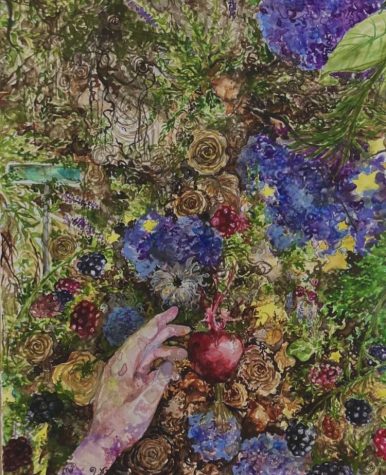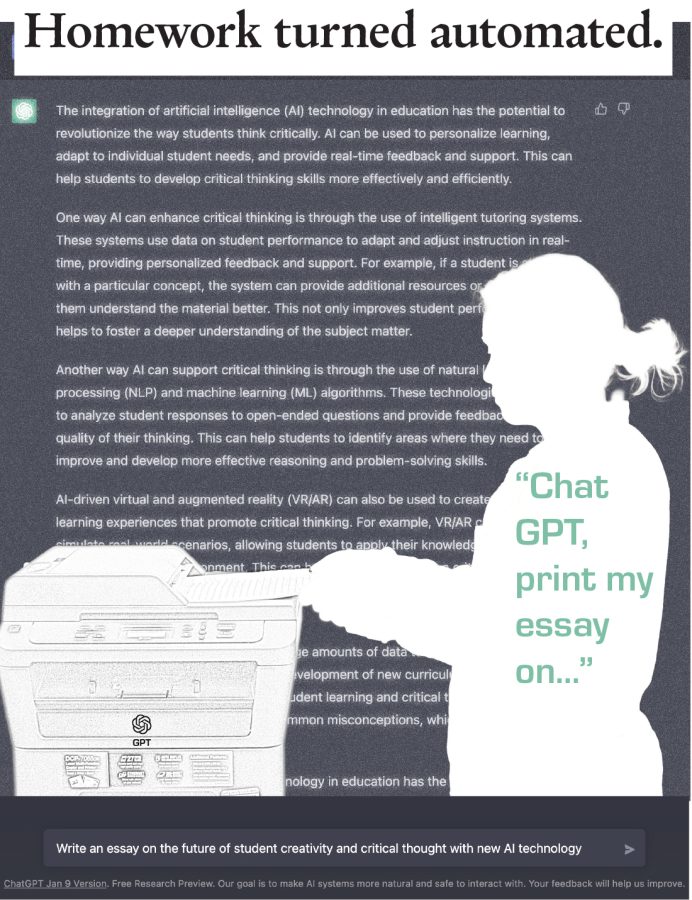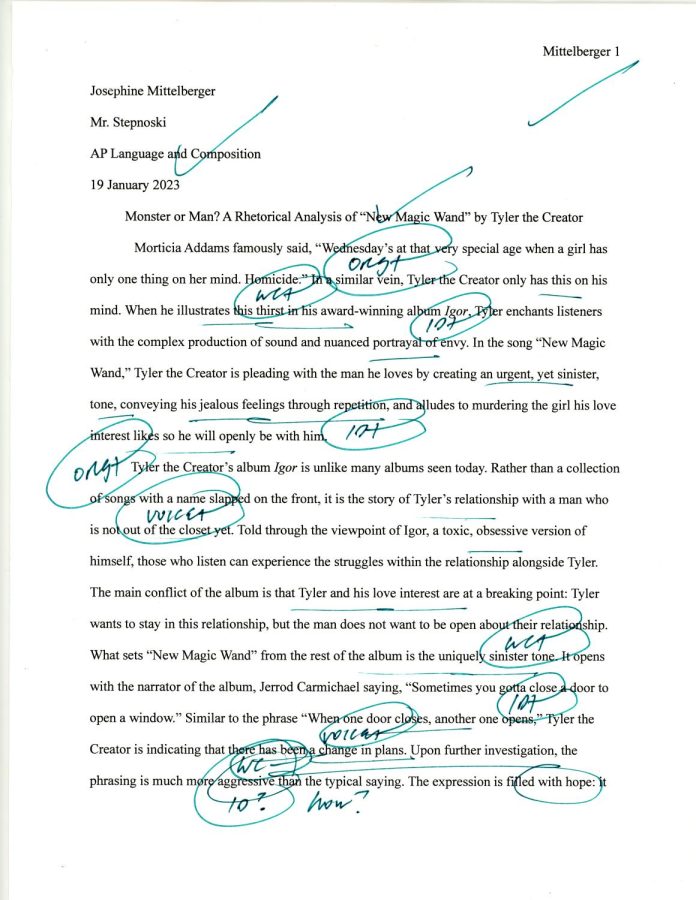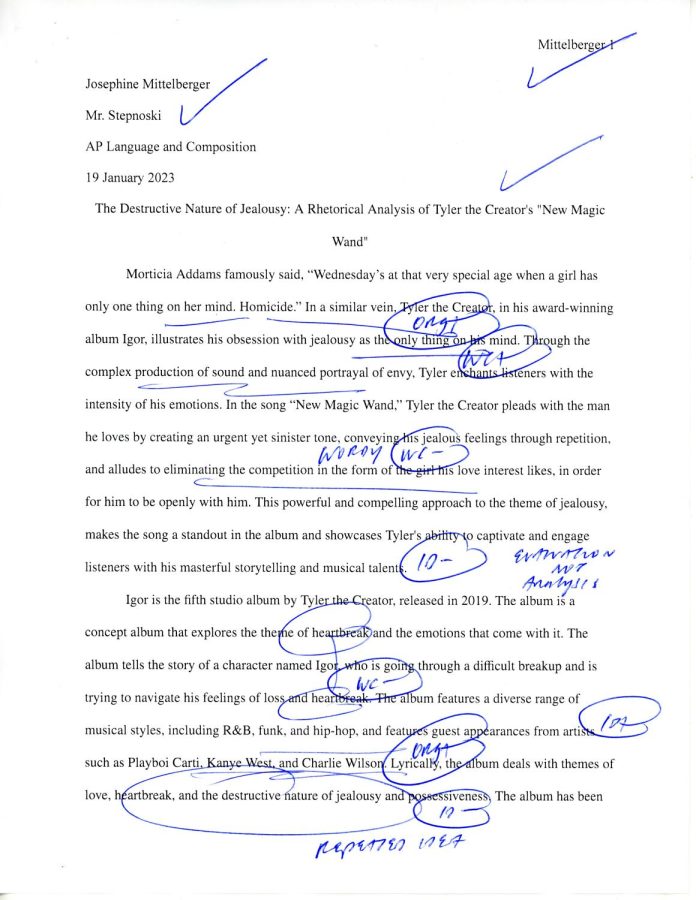Marianna Young & Reena Alsakaji
COPY AND PASTE Printing out a mock essay from ChatGPT, Gaby Ruiz, senior, poses for a photo. Since ChatGPT’s release, school districts have feared that students will utilize this resource for plagiarism.
Homework turned automated: following ChatGPT’s release in November, students and teachers discuss its implications for education and student creativity, as well as other AI
January 25, 2023
Calculating the score of the essay generated by ChatGPT, Mr. Steven Stepnoski, English teacher, mutters, ‘That can’t be right.’ Punching in the numbers into the calculator once again, he sighs in defeat as he writes “88.”
As an experiment alongside our ChatGPT coverage, Crier gave Mr. Stepnoski two essays to grade: one was written by Josephine Mittelberger, senior, and the other was generated by ChatGPT based on her essay. There was a 10% difference, and Mr. Stepnoski noted that the essay did not flow. While the ideas connected logically, the sentence structure and word choice lacked voice and style.
“Spotting the writing style differences would be a lot more challenging to do without knowing someone’s writing voice or style previously,” Mr. Stepnoski said. “It got repetitive, and that’s where my antenna went up: this sort of seems like an automated voiceless style of writing.”
While creating the essay with ChatGPT, Crier found that, if not given the information about the essay topic, the AI system was not accurate. Students such as Stephen Glombicki and teachers such as Mrs. Lemon found this same issue—the program would confidently spill out false information when asked about specifics in books or questions in regards to math.
![]()
“It thinks like a human.”
“It’s able to consume so much information at once. It does not write like a human, but I feel like it thinks closer to humans than most other things would,” Anthony Bellahcen, senior, said.
Since ChatGPT’s release in November, several school districts have rushed to block the program, according to the New York Times, claiming that it hinders student creativity. Currently, students cannot access any OpenAI program on their school laptops, both in the building and outside of it. According to a Crier survey of 218 responses, from Jan. 12-23, approximately 12% of students have used ChatGPT or another AI for an academic subject, and 37% of students know others do so. Sarah Espiritu, senior, finds the program conflicts with her values as she plans to become an English teacher in the future.
“So long as AI keeps advancing to know what professors want in papers, students are never going to learn how to be their own writer and have a voice. It’s just going to be the same—confined to a box,” Sarah said. “ Personally, but as a future educator, all I can do is encourage students to want to learn—not to just give them a deadline, or say you have to submit this because of the curriculum. I’m giving you a deadline because I want to instill a want to learn of the subject.”
![]()
“There is an inherent value in the struggle.”
The overarching concern of teachers with ChatGPT is that rather than using it as a tool for learning, students will instead use it in moments of desperation when the deadline is too close to finish the work on their own. Mr. Benjamin Boruff, English teacher, found that ChatGPT and other AI generating programs challenge teachers to encourage their students to learn how to struggle.
“It just makes it all the easier for someone to not to not learn and grow as a writer,” Mr. Boruff said. “I think this will be an issue moving forward in English classes everywhere, but learning will still happen. It’s hard to do, but to convince folks that there is an inherent value in going through the struggle to get to the end result. The more people I can convince of that, the less likely they’ll rely on something like this.”
While there are sources out there that can potentially detect if an essay was created by ChatGPT, because there is no guarantee that an essay was created with an AI system, it would be difficult to accuse a student of cheating. Mrs. Brook Lemon, English teacher, compared this to accusing a parent of writing their child’s essay—unless a child says it, there is no way to prove that theory.
“I think it’s a really good point that teachers need to make sure they know their students and know what they’re capable of,” Mrs. Lemon said. “This shouldn’t be the first time they’re seeing their writing. They should know what their writing is like, but sometimes you just never can pick it out.”
Programs such as ChatZero have stated that they can detect plagiarism. Increasingly, students have found their way around this. Students reported using the program for both essays and other extracurriculars, such as Science Olympiad and Debate.
![]()
“But why not take advantage because you can’t put the genie back?”
While the immediate reaction of many involves concerns over shortcuts and plagiarism, other teachers find that this content can be helpful—or, rather, schools should be working with the program rather than against it. Mr. Ryan Popa, cybersecurity and business teacher, initially wanted to use the program for his business class—with business teaching, “time is money.”
“My first thought was, education is over as we know it. Students cheated enough,” Mr. Popa said. “But why not take advantage because you can’t put the genie back? The big thing is, how do we teach with the genie and make it useful. Going forward, there’s going to have to be some marrying of the two. If we’re going to truly educate you to move on into careers, those careers are going to be using bots.”
“Don’t Ban ChatGPT in schools, Teach with it” published by the New York Times stated that banning the program was the wrong move for several school districts—primarily because the attempts would not work in the long run or real world and partially because it can be used as a resource for teachers.
Besides being used for academic purposes, Chat GPT has been a powerful tool in helping those with errors in their code, fix the small bugs. Stephen Glombicki, sophomore, takes it one step further and uses a sister program to help write up to half of his code: all he has to do is push “tab.”
“I think it is powerful and I like the tool a lot, but it definitely has its bad side,” Stephen said. “It has to have better content moderation, you can’t ask it stuff that is harmful. It is a cybersecurity threat. A bunch of people have been asking it to write vulnerabilities.” into programs.”
AI versus human-made: which is which?


Guess which piece of artwork was created by hand vs. by Dalle-E 2 (see answers at the bottom of the page)
![]()
“You can’t make a dataset out of someone’s brain.”
Another form of AI on the rise is AI art like Dalle-E 2, which has split the artist community. AI art is created through instructions on how to replicate certain aesthetics; some systems will take existing images to create new pieces of art. There are systems that claim that what they create is unique, like AICAN—which does not pull from photos like other AI systems, but is instead fed tens of thousands of photos to learn different styles that spans over multiple centuries. As someone who is a part of smaller artist communities, Jemma Jacobsen, senior, is afraid of the implications that AI art holds with stealing the work of other creators.
“Art is a strong expression of all of my feelings,” Jemma said. “I draw things that I believe are beautiful. It’s all like coming from inside my brain, which you can’t make a dataset out of. A lot of people expect art to be free and do not realize the amount of time and effort that is put into creating quality artwork. Everyone can create art, and that is beautiful. I think that we’ve lost sight of the fact that just because it is a commodity doesn’t mean it’s not valuable.
A look into the essay
Crier gave Mr. Steven Stepnoski, english teacher, two sample essays. Below is one sentence written by one of our staff members, and the other is written by ChatGPT. Guess which one is which (answers at the bottom of the page)
1. “This line serves as an introduction to the theme of the song, which is about the lengths that one might go to in order to eliminate perceived competition in a romantic relationship.”
2. “He follows the line by directly addressing the audience, the man he is in love with, which confirms the aggressive tone that was established in the narration.”
See the essays below:
Josephine Mittelberger, design chief:
Chat GPT:
Answer key:
The illustration on the left was created by Jemma Jacobsen, senior. The illustration on the right was created by Dalle-2.
Sentence #1 was generated by ChatGPT.


